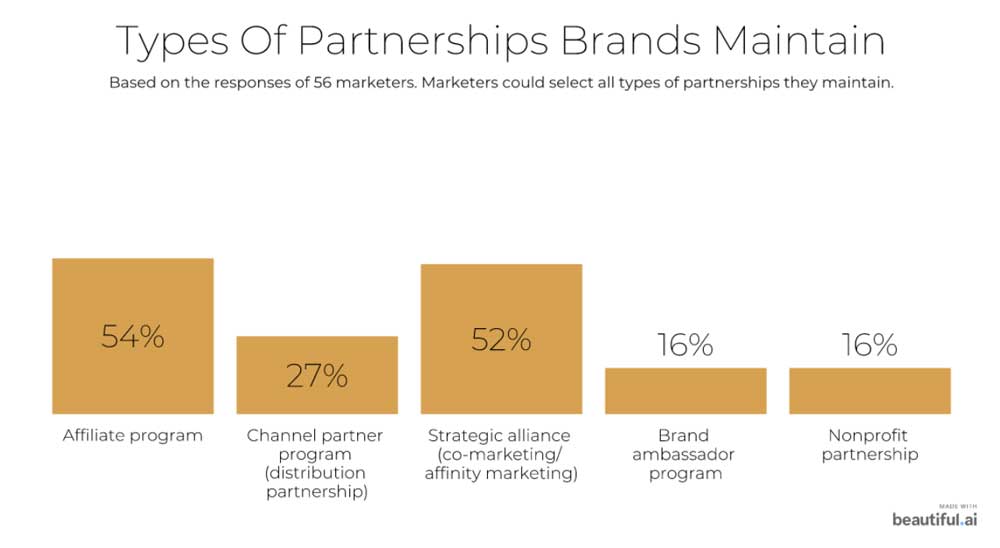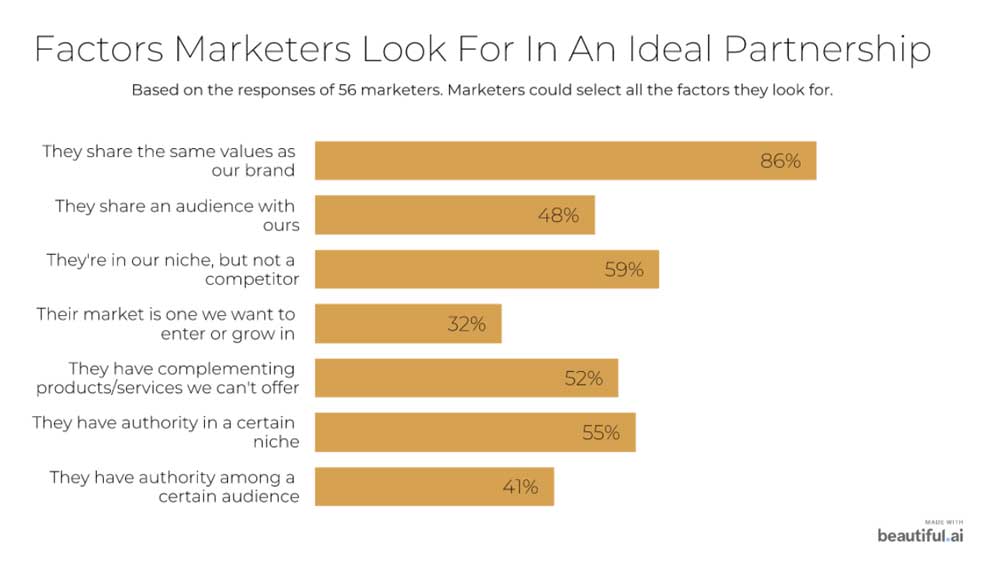Creating business partnerships is a piece of cake. You jump on a call, figure out what’ll you get from the relationship, and pull the trigger. There you have it. You’re all done!
Except, that’s not how you create lasting partnerships.
As with any relationship, lasting business partnerships take work as you do your research, sit at the discussion table, and then work to sustain the relationship long after you’ve signed the agreement.
The key, however, is in planning the partnership carefully so it develops well and deepens in time.
Not sure how to go about doing that? Don’t worry, we can help.
In this post, we curate the factors to consider before you strike up a partnership, as well as the most common types of partnerships among businesses. (If you already have an existing partnership, you might enjoy our other post on maintaining lasting partnerships.)
Ready? Let’s dive in.
The first step to lasting business partnerships
Before diving into the factors to consider when entering a partnership, let’s look at what kind of partnerships businesses are typically interested in.
Through our survey of 56 marketers, we learned most brands pair together in affiliate programs. In fact, 54% maintain affiliate program partnerships.
Another 52% also maintain strategic alliances, where they explore and execute co-marketing opportunities; and 27% maintain channel partner programs. Lastly, 16% of marketers are interested in brand ambassador partnerships and the same number are into nonprofit partnerships.
We also asked contributors to vote on factors they considered to be critical in striking ideal partnerships. We ended up with some interesting takeaways:
- 86% said shared values between brands are crucial
- 59% admitted partners must be in the same niche but not in competition
- 55% noted ideal partners should have some authority in their niche
- 52% pointed out their partners should offer complementary services they don’t offer
- 48% said ideal partners should share their audience, and 41% say they should have authority in that audience
- 32% think partners should be from a market they want to enter or grow in
13 things to consider before entering partnerships
Now that you know which types of partnerships are popular among brands, let’s look at the factors to consider before partnering with others.
1. Run a background check
Before anything, it’s crucial you research your potential partner.
Take to the internet. Google their brand and look for anything that stands out as shady. You can also research them on social media and ask around in your network if needed.
In short, “do extensive background checks,” advises Jacek Ptak from KrakowDirect. “Partnering with a company with a bad press can be nothing short of a disaster.”
The Trip Outside team does the same. Julie Singh writes, “Before entering into a partnership, we evaluate the company’s reputation, reviews, and ratings to make sure they are highly regarded and provide awesome customer experiences to their customers.
“This is important because they will be serving our customers soon, and this helps us ensure that we work with and feature the best companies on our website.”
2. Learn about your potential partner
Once you’ve run a background check, “take time to learn about your future partner: Who is their target audience and how do they engage with the audience,” Pierre-Camille Hamana from Hospitable points out.
“You need to make sure you talk to the same people as your future partner and have similar brand values. Your partner will be using your brand name in their communication from time to time, and you must be sure it appears in a favorable context.”
In addition to needing similar brand values, you need to do your homework on what your potential partner’s goals are and if your company has the ability to help reach them. This will not only improve alignment between your companies but also ensure that you provide mutual value in the long run.
As Adam Pasch, Head of Partnerships at Impravado, explains in his Greatest Minds in Partnership interview: “It’s about focusing on how can I help partners grow their business. What the strengths, weaknesses, opportunities, and threats are, and how can my business help overcome them.”
3. Have a dedicated point of contact
Hamana shares another tip: “Make sure you have a dedicated person in your team to address requests from your partners. Keeping your partners waiting for your response won’t do you any good.”
Chanty’s Dmytro Okunyev also lists this factor as important for lasting partnerships. “In my opinion, main factors that will help increase the odds that a partnership will be lasting are the following: general plan of your future activities with step-by-step descriptions of each stage, settled budget, and a small team of professionals, who can support the whole process on the proper level.”
And, another one of our expert contributors, John Ross of LSAT Test Prep Insight goes on to say, “The best thing to have in place prior to entering a business partnership is a point of contact within your company who you trust to interface with your partner and set the parameters of the relationship.
Furthermore, “you must also have the infrastructure in place to gather and analyze data on the performance of the partnership. Data analysis is key to measuring ongoing performance.”
4. Have a clear goal in mind
Next up, it’s crucial you come to the partnership table with a clear goal. What is it that you want from the partnership? And equally important: what is it you want to give to your partner?
In fact, “a brand needs to know exactly what they want to get out of the partnership, and they need to also know what they can reliably offer in return,” says Nikola Roza of SEO for the Poor and Determined.
“For example, if a brand wants to participate in a guest post link exchange, they need to reliably be able to put out X number of guest posts per month. Otherwise the partnership will quickly end.”
As for a real case in point, Surfer SEO’s Michał Suski shares his experience. “We’re an SEO tool for on-page optimization, so we hit up partners who have some sort of authority in the field.
“Most of our affiliate partners have their own blogs, YouTube channels, and webinars, the aim of which is to help their audience. That’s common ground with us.”
To this end, it’s also crucial that “brands have a goal of where they want to be and who they want to target before entering into a partnership,” muses Teri Shern of Conex Boxes.
“These goals will guide the entire process and help you to make key decisions in choosing the right businesses for the partnership.”
5. Ensure it’s a mutually beneficial partnership
Another important factor to consider is how a partnership benefits the involved partners. Does it benefit both or does it skew in favor of one partner?
“First of all, you need to assess whether the partnership will be profitable for both sides,” Jacek Ptak says.
“My primary factor when deciding on a partnership is complementary services. For instance, we’re a touring and transportation company, so we partner up with hotels and restaurants. This works like a charm, as both us and the partner come out on top.”
“For any partnership to last, it has to be mutually beneficial for both parties,” agrees MuteSix’s Greg Gillman. “However, some companies only look at the present, and what can be a quick exchange of opportunities.
“For a partnership to be long-lasting, it’s important to look at the bigger picture, and understand how to adjust the partnership as both companies change and grow.”
6. Make sure both partners have similar values
One major factor that ensures partnerships will be highly valuable for both sides is when partners share similar values.
Tim Denman from ServGrow highlights, “You have to make sure both parties have similar values and goals in a partnership. You also have to establish boundaries of what you’re comfortable with to avoid someone over-stepping. Most of all, you have to like working with that person. If you do not get along, you will not last.”
7. Determine if the partnership will contribute to your growth
“Before entering a partnership, you must consider that the obvious choice for a partnership may not be the best choice,” notes Alex Birkett of Everything But The Plant.
“Entering a partnership with an old friend seems like a good idea on the surface, but are they going to challenge you? Will they let you know when they believe you are making the wrong move? A competitive, professional relationship is the better choice in this situation.”
Manny Vetti from BackTaxesHelp echoes the same. “Before entering a partnership, you have to make sure you are partnering up with someone who can help your business grow. Invest in similar niches. Get on a video call with them before making a decision. Get a feel of the other person before working with them.”
In a nutshell, a general partnership that doesn’t encourage you to grow is not worth pursuing.
8. Make sure you’re not competitors
Adding to the idea of partnering with people from similar niches, Petra Odak of Better Proposals suggests, “The number one thing to keep in mind is you need to be in the same or similar industry but the product should not be competing against yours.
“Some of the best partnerships we have are with companies in our industry that have products complementary to ours.”
9. Set clear expectations
It’s also essential “before you start a partnership, both entities must set clear expectations of the other,” notes Mike Falahee from Marygrove Awning.
“Without these guidelines and boundaries, unnecessary conflict will be created. Setting the structure of these expectations will eliminate any gray areas and misunderstandings in the future.”
Once you’ve verbally set clear expectations, the next step is to put it in writing – which leads to our next point.
10. Make sure everything is in writing
Once you’re sure the partnership you’re entering into is a match made in heaven, get everything in writing. This keeps confusion at bay and everyone on the same page.
David Cusick from House Method suggests: “Lay out the details of the partnership, responsibilities and contributions of each party, business structure, potential issues and how to resolve them, and so on. These will ensure the legality of your partnership, and if things fall apart, everything is backed by documents.”
Travis Killian of Everlasting Comfort explains, “Questions will surely come up with any partnership, but the more you can address in the beginning, the best for both parties.” For this reason, he recommends having “a set of targeted, thorough standard operating procedures.”
Rachel Jones from Hope Health Supply agrees. “To be sure that a partnership is lasting, there should be standard operating procedures and company processes established from the very beginning. The reason many partnerships fail is because they are not equipped to handle particular challenges that could have been addressed from the start.”
11. Be honest and transparent from the get-go
“The first step toward a successful partnership is honesty,” suggests Nick Chernets of DataForSEO. “There is no way you can build a relationship of trust if you or your partner are not completely honest.
“This doesn’t mean you need to reveal every single detail about your business. But you need to be open to talk about things relevant for the partnership.”
Neil Desai from Wandering Bots Ltd highlights the need for“100% transparency. It’s always best to be transparent with your partners about your limitations. This is better than overselling to get a foot in the door.
“Our strengths and limitations are what make us unique. I’ve seen again and again when companies win a tender with another company, only to be found out six months down the line. When there’s transparency, you both give each other the benefit of the doubt and allow the partner to make workarounds.”
12. Regular communication
Desai shares another useful point for creating partnerships that last: regular communication.
“Make sure the partner gets any updates on your business directly from you,” he comments. “This can be done through an integrated communications plan: a mixture of recurring meetings, newsletters, emails, or even Slack communication. It could also be mixed with more informal settings (depends on the relationship).
“There’s no fixed rule for this, as long as both parties respect one another. These are just a few examples. There are numerous and creative ways to keep the communication going without overwhelming the partner.”
13. Dedicate time to the new partnership
Time is an often unlooked factor for creating lasting partnerships. However, “before you enter into a new partnership, the most important factor in maintaining a lasting partnership is to treat it with the highest importance and investing time and effort into it,” says Akhila Ajith of StartupNameCheck.
“A lasting partnership is all about quality over quantity. Providing value and importance to the partnership will not only keep both sides of the parties satisfied, but it will enhance their relationship, which may even open to new opportunities.”
To sum things up
Entering into a partnership that lasts takes some work. Always start with background research and studying potential partners, their business, values, niche, and target audience.
It’s only when you find an overlap in your niche, audience, interests, and business values that you should consider striking up partnership with them.
But, remember, no matter what you decide, be transparent, set clear expectations, and have everything in writing.






